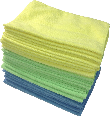What is grout? Here's what Merriam Webster says: "Grout is a thin mortar used for filling spaces (as the joints in masonry); also, it is any of various other materials (as a mixture of cement and water or chemicals that solidify) used for a similar purpose". In other words, it is that white plaster-like stuff between tiles that always seems to accumulate stains that you can't even reach, let alone clean. Removing stains from grout takes patience and diligence, but don't worry, we'll tell you how.
To begin with, the best way to remove stains from grout is to first work on the dirt trapped in it. You can do that by applying a liquid cleaner on the grout and letting it stand for at least fifteen minutes. That softens the stains and allows you to clean them off with a wet-dry vacuum. If your tiles are laid very close together, the grout lines between them are so narrow that they do not easily accumulate dirt.
An effective preventive option is to seal the grout. Unsealed grout is a magnet for dirt, grime, slime, mold, and mildew, which will leave horrible green, brown and black stains. Most grout sealers, readily available at hardware stores, are quite expensive, but the investment is worth making for the time, effort and money it saves you later.
As a rule, before you begin removing stains from grout, make sure there is no excess moisture in the area by wiping it with a clean, dry towel. If the grout is breaking up, you may have to replace it rather than waste time trying to clean it.
Finally, try to make sure you don't trudge all over your tiles with dirty shoes on. There's nothing like shoes to get dirt on grout lines. If you can't leave your shoes outside the door, at any rate use doormats and exchange outdoor shoes for indoor ones when you come in the door.
Mold and mildew stains are the most common stains that form on grout, particularly in bathrooms. Chlorine bleach is the best antidote in this case. Do not apply pure bleach directly onto the grout, but use bleach diluted with a little water. Once you pour the solution along the stained grout lines, scrub gently with a stiff-bristled brush to make sure the solution sets on the stains and disinfects them. After about fifteen minutes, rinse the area thoroughly.
Warning: When you are using chlorine bleach or any strong chlorine-based solution, you must always wear gloves and safety goggles, and make sure your surroundings are thoroughly ventilated to prevent exposure to the pungent chemical fumes of bleach.
While commercial cleaners are the easiest way to remove grout stains, you can actually make your own grout cleaner at home. Not only is it almost as effective as commercial chlorine bleaches, but it is also far safer. The mixture is one of about four tablespoons each of baking soda, ammonia, and white vinegar diluted in at least a liter and a half of water. Pour the mixture in a spray bottle and mix well before spraying it along grout lines. Leave it standing for at least fifteen minutes before rinsing it off.

The Power of Microfiber! Zwipes Microfiber Cleaning Cloths will become your favorite tool for every cleaning task. This 36-cloth package is perfect for hundreds of uses in the garage, kitchen, bathroom, laundry, and all around the house. Each cloth is tough, streak-free, lint-free, reusable, and washable. Check out Microfiber Cleaning Cloths today!
Bamboo flooring is beautiful and can last for a long time, if you take care of it properly. But what to do about stains? ...
Discover MoreGrowing up we were always told to never cry over spilled milk. But what about the stains left behind? Crying over those ...
Discover MoreHardwood flooring, while a beautiful addition to the home can be a serious pain in the butt. That being said, they are ...
Discover MoreFREE SERVICE: Get tips like this every week in Cleaning Tips from Tips.Net. Enter your address and click "Subscribe."
There are currently no comments for this tip. (Be the first to leave your comment—just use the simple form above!)
FREE SERVICE: Get tips like this every week in Cleaning Tips from Tips.Net. Enter your address and click "Subscribe."
Copyright © 2026 Sharon Parq Associates, Inc.
Comments